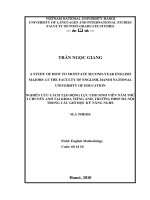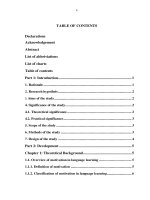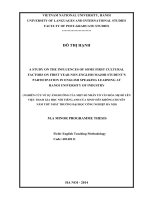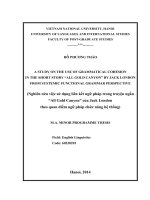A study of the mechanisms of immunity to pasteurella haemolytica infection
Bạn đang xem bản rút gọn của tài liệu. Xem và tải ngay bản đầy đủ của tài liệu tại đây (13.04 MB, 297 trang )
A study
of
the
mechanisms
of
haemolytica
immunity
to
Pasteu. rel. la
infection.
I
HELEN BARBARA EVANS
A thesis
for
submitted
University
the
degree
of
1979
ZG
dý8N10ý
of
Edinburgh
Doctor
of
Philosophy
DECLARATION
The
work
project
concerned
diseases
of
findings
were
at
the
sheep,
and
Research
work
presented
and
where
conjoint
was
played
in
design
of
the
results.
thesis
was
in
the
a large±:
of
respiratory
with
Institute.
experiments
part
some of
collaboration
this
of
of
consequently
in
obtained
Moredun
this
investigations
with
the
tation
in
reported
the
experimental
my colleagues
Nevertheless,
thesis
carried
out
necessary,
a
was
were
experiments
most
and
the
by
of
myself
full
role
interpre-
W O1 C-/aAAs
HELEN
October
EVANS
1979
CONTENTS
Pa qe No
DECLARATION
Summary
1-
Acknowledgements
4
Abbreviations
GENERAL
in
used
text
INTRODUCTION
Characterisation
of
The distribution
healthy
amongst
Diseases
of
P. haemolytica
Septicaemia
2.
Pneumonia
P.
of P.
sheep
sheep
1.
for
Requirements
P. haemolytica
haemolytica
haemolytica
associated
Experimental
in sheep
Septicaemia
2.
Pneumonia
Models
of
laboratory
7-
38
10-
17
18-
19
20-
26
vaccine
for
study
against
of
27
infection
with
of
P.
pasteurellosis
haemolytic
animals
GENERAL MATERIALS
AND METHODS
Bacteriological
techniques
Strains
of
P. haemolytica
Strain
of
Escherichia
Enumeration
Laboratory
6
with
a suitable
and methods
reproduction
1.
5-
types
efficacy
vaccine
3
of
animal
Mice
Inoculations
1.
Subcutaneous
2.
Intraperitoneal
3.
Intranasal
28-
31
32-
38
39-
56
39-
41
42-
43
in
coli
bacteria
techniques
Vaccines
page
No
44-
48
49-
56
57-
88
58-
59
Antigens
1.
Preparation
of
P.
2.
Preparation
P. haemolytica
of
heat-killed
Preparation
of
Absr rption
hydroxide
of
Emulsification
oil
mineral
of
Bovine
vaccine
Techniques
collaborators
for
sheep
P.
in
antibodies
lambs
with
P13 virus
and
bacteriology
and
Quantitative
P.. haemolytica
enzyme-linked
P.
lungs
mouse
sera
Pathology
1-
of
haemolytica
Challenge
of SPF
P. haemolytica
Chapter
to
responses
examination
test
with
antigen
transformation
Lymphocyte
P. haemolytica
antigens
IHA
aluminium
onto
absorbed
by
employed
Histological
SSE
vaccines
antigens
albumin
haemotica
to
estimation
of antibody
in sheep sera by a micro(ELISA)
immunosorbent
assay
Experimental
infection
of
mice
with
haemolytica
Introduction
Materials
and
Experiment
varying
with
1-
Methods
Intranasal
numbers
of
2Viable
Experiment
in the lungs
of mice
Experiment
thiopentone
intranasal
Experiment
live
and
infection
P. haemolytica
of
mice
60-62
counts
of P. haemo]_ytica
infection
after
3-
Comparison
of halothane
for
sodium
as anaesthetics
infection
4Comparison
of IN ii_ection
heat-killed
P. haemolytica
63-
64
65-
67
68-
70
and
with
Page
No
71-
72
73-
74
75-
77
8The effect
Experiment
of
of vaccination
P. haemolytica
type Al vaccine
mice with
in the liver
of organisms
upon the growth
following
IP challenge
P. haemolyti.
ca
with
type Al 3 weeks later
78-
80
Discussion
81-
88
5-
Experiment
procedure;
challenge
Intraperitoneal
challenge
for
preparation
of inocula
of mice and determination
of
Experiment
type
Al
in
6-
Growth
of
the
livers
and
P.
IP
LD50
haemolytica
of
spleens
normal
mice
Experiment
SC routes
type
tica
7prior
Al
Vaccination
to challenge
2Mechanisms
Chapter
in sheep
ytica
of
of
immunity
mice by IP and
P. haemoly
with
to
P.
haemol89-108
Introduction
Materials
and
Methods
]Growth
Experiment
of
in the presence
in vitro
and serum
P.
of
haemolyti
ca.
lung wash cells
2Experiment
The roles
of antibody
immunity
(CMS) in combined
mediated
P13 virus
of SPF lambs with
and P.
type Al
91-
92
93-
95
and cellinfection
haemolytica
97-103
104-108
Discussion
3Non-specific
Chapter
P. haemolytica
resistance
to
109-129
Introduction
Materials
and
Methods
1The effect
Experiment
given
of Carovax
24 hours
to mice 48 hours,
and 6 hours
to challenge
prior
upon the LD
of P. haemol. y50
tica
110-111
112
Page
treatment
to
prior
of
growth
2Experiment
Effect
of vaccine
intervals
time
mice at different
P. haemolytica
on
with
challenge
in the liver
bacteria
Effect
of dilution
of challenge
with
4Experiment
dual
components
Effect
of treatment
on
of the vaccine
5-
Experiment
B188
with
of Carovax
P. haemolytica
116-117
P.
with
challenge
of
113-115
3Experiment
on the outcome
type Al
of
No
Al
type
haemolytica
Determination
indiviwith
the outcome
LD5
of
of
'treated
.
E.
co"
untreated
mice and in mice
24 hours
before
challenge
vaccine
in
118-119
120-121
6Effect
with
Experiment
of treatment
24 hours
before
Carovax
with
challenge
B188 upon the growth
E. coli
of the organism
in the livers
of mice
122-123
Discussion
124-129
4Chapter
and challenge
into
investigations
Further
P. haemolytica
of mice with
vaccination
130-1153
Introduction
Materials
and
1Experiment
of P. haemolytica
mice
and
and challenge
135
A2,
Al,
types
with
A6
136-138
A9
Experiment
procedures
3upon
P. haemolytica
Effect
of
challenge
type
4-16
Experiments
types
different
of
by the model
gated
P. haemolytica
with
Experiment
P.
of LD Q values
Zack
for
C57
Determination
strains
2Vaccination
a
of mice with
(types
Al,
A2 and A6) P. haemo3ytica_
Experiment
trivalent
vaccine
132-134
Methods
haemolytica
challenge
Discussion
17 -
139-142
A2
Cross-protection
P. haemolytica,
of IP challenge
P.
between
investiof
mice
143-144
Vaccination
type
with
vaccination
various
of mice with
A9
SSE
haemolytica
of
mice
with
and
HKO,
and
typt-
A9
145-147
148-153
Page
Chapter
5-
for
tica
detection
from
sera
the
in
Development
IHA
of
and
to
of antibodies
vaccinated
mice
No
tests
ELISA
haemoly-
P.
154-121
Introduction
Materials
and
1-
Experiment
for
dilutions
157-159
Methods
Determination
mouse
of
in
sera
IHA
end-paint
tests
homologous
and heterologous
using
SSE extracts
P. haemolytica
160
2Preliminary
titration
Experiment
of
P. haemolytica
type Al SSE in the presence
to
of immune mouse serum and titrations
dilutions
determine
optimal
of conjugate
3-
Experiment
Titrations
of
sera
types
of P. haemolytica
antigens
dilution
conjugate
using
at 1/200
comparable
achieve
at
absorbance
4Experiment
of cross-reaction
P. haemolytica
and
161-163
SSE
Al-A12
to
400 nm
164-165
degree
Determination
of the
between
the types
in the. ELISA test
of
166-167
168-171
Discussion
DISCUSSION
CONCLUDING
Mechanisms
of
172-190
immunity
to
P.
in
haemolytica
174-1.81
sheep
Models
of
P.
haemolytica
infection
in
mice
182-190
191-212
Bibliography
Appendix
1
213-214
Appendix
2
215-217
Publications
arising
from
this
thesis.
218
1
SUMMARY
to
Immunity
using
was
studied
in
infection
haemolytica
P.
of
models
haemolytica
Pasteurella
both
lambs
and
mice.
Immunisation
.vaccine
of
specific
a sodium
containing
P.
haemolytica
type
Al
P.
haemolytica
type
Al,
type
parainfluenza
of
responses
increased
lambs
transfer
this
although
by
haemolytica
alveolar
from
by
from
to
P.
vaccinated
The
passive
repeated
did
säure vaccine,
upon
failed
serum
leucocytes
Serum
effect
with
transformation
produced
challenge.
with
Lymphocyte
serum,
not
protect
lambs
vaccinated
in
haemolytica
facilitate
vitro,
phagocytosis
in
macrophages
a
of
infection
upon
challenge.
the
with
challenge
against
after
with
a bacteriostatic
had
P.
blood
lambs
from
recipients
3 virus.
markedly
of
vaccination
extract
superimposed
hyperimmune
of
salicylate
protected
peripheral
lambs
pathogen-free
of
vitro.
w
Two models
were
caused
cleared
because
similar
haemolytica
Intranasal
investigated.
llytica
P.
of
lesions
from
in
the'lung
lesions
infection
the
by
were
in
infection
lung
of
mice
3 days
48 hours
produced
later.
after
bj
the
were
mice
with
P. haemoBacteria
infection,
introduction
and
of
2
heat-killed
haemolytica,
P.
this
model
was
investigated
not
further.
P. haemolytica
gastric
vaccination
of
tica
sodium
containing
types
various
The
to
type
Al,
commercial
24 hours
or
14 days
no
such
before
detection
vaccinated
of
mice.
vaccine
was
immunosorbent
There
to
P.
was
of
between
mice
the
P. haemolytica
that
was
given
with.
P.
was
used
Carovax.
vaccine,
challenge,
indicating
challenge
antibodies
challenge
cross-protection
with
protection
An enzyme-linked
haemolytica
challenge
before
coli,
the
Vaccines
against
protected
Pasteurella
challenge
When
non-specific.
haemoly-"
P.
observed.
the
Escherichia
also
The
of
P.
of
in
spleen.
investigated.
little
intraperitoneal
against
protected
T10
of
12 or
and
extracts
was
-and
was
liver
extracts
and
strains,
investigate
7 days
All
strains
When given
and
A8,
model
liver
the
intraperitoneally
mice
various
salicylate
homologous
with
the
A6,
Al,
the
with
in
growth
upon
to
in
multiplied
mucin
effect
introduced
vaccine
type
Al,
protection
1 hour,
was
48 hours,
haemolytica
observed.
assay
haemolytica
considerable
was
in
developed
the
sera
cross-reaction
for
of
between
sera
extracts
of
from
the
mice
different
immunised
types
with
of
P.
sodium
salicylate
haemolytica.
4
Acknowledgements
am deeply
I
Dr.
G. H.
out
this
grateful
to
for
their
Lawson
K.
project,
thanks
My sincere
Sharp,
M.
Dr.
J.
for
many
and
for
are
also
Dr.
N.
Burrells
for
advising
aspects,
Dr.
B Rushton
on
Mr.
pathology,
house,
Mr.
pbs,
Mr.
B.
would
librarians
reading.
Research
Council.
A.
like
also
typing
and
Mr.
at
this
L.
to
McVittie
Mr.
A.
Suthe-rland
to
the
Moredun
manuscript
Throughout
Studentship
this
awarded
Mr.
I was
the
and
the
advice
animal
of
photograI
assistance.
Evans
project
by
help
of
and
Miss
A.
technical
many
for
C.
statistics,
Skeoch
J':
Donachie
Mr.
preparation
Institute,
and
and
technical
Miss
W.
to
staff
on
for
for
thank
the
advice
Inglis
Mr.
and
W. Angus
and
for
Aitken,
D.
tests
Mr K.
through-
encouragement.
am endebted
me on ELISA
C.
I.
Dr.
Gilmour
I
and
and
advice
due
J.
M. McLauchlan
Easter
and
their
and
supervision
excellent
discussions.
useful
P. W. Wells
Dr.
G.
for
Miss
A.
Sclater,
for
Armstrong
help
supported
Agricultural
C.
with
by
proof.
a
Research
-
5
Abbreviations
AM
= alveolar
BA
= bovine
C.
=
control
CFA
=
complete
cfu
=
colony
CMI
=
cell-mediated
DW
=
distilled
E=
in
used
text
macrophage
albumin
Freund's
forming
adjuvant
unit
immunity
water
absorbance
ELISA
=
gelatin-Hanks
= Hank's
immunosorbent
enzyme-linked
0.1%
balanced
salt
solution,
assay
containing
gelatin
HBSS
= Hank's
H. E.
= haematoxylin
HKO
= heat-killed
HuRBC
= human
IFA
= incomplete
IHA
indirect
=
IN
= intranasal
IP
intraperitoneal
=
IT
= intratracheal
balanced
solution
salt
and
eosin
organisms
blood
red
cells
Freundes
adjuvant
haemagglutination
intravenous
IV
=
MIF
= macrophage
MV
missing
migrätion
value
inhibition
factor
6
broth
NB
=
nutrient
ND
=
not
done
n. t.
=
not
treated
density
OD
optical
PBS
phosphate-buffered
saline
PBS/Tween
phosphate-buffered
saline
Tween
P13
=
containing
20
type
parainfluenza
PVP
polyvinyl
RBC
red
SC
subcutaneous
SE
standard
error
SED.
standard
error
3
pyrrolidone
blood
S. I.
=
stimulation
SPF
=
specific
SSE
=
sodium
V
=
vaccinate
cells
of
difference
index
pathogen
salicylate
free
extract
of
means
0.05%
INTRODUCTION
GENERAL
is
Pneumonia
of
sheep
necropsied
it
cause,
considerable
in
least
its
bacteria,
lungs
of
the
the
organism
is
1954).
with
a variety
also
of
studied
predominantly
basis
of
important
not
cattle
in
of
and
Particular
associated
the
certain
types
with
is
to
is
c
and
have
organism
pneumon'. a and
Europe
been
into
subdivided
and
and
or
America
biochemical
the
may
sheep,
pneumonia
P. haemolytica
of
the
a septicaem
North
species
from
conditions
restricted
both
with
characteristics
which
with
at
Pasteurella
clinical
other
associated
of
is
similar
of
is
The characteristics
features.
which
isolated
may be
frequency
greatest
most
(Carter,
the
some
of
associated
fever"
on
is
commonly
"transit
types
disease
is
P. haemolytica
extensively
the
from
stages,
the
organism
to
terminal
from
disease.
industry
the
losses
pneumonia,
Organisms
sheep,
may not
report
The
the
isolated
the
consequence.
haemölytica.
be
that
likely
1977).
economic
and
with
total
the
is
in
quoted
reflect
accurately
this
figures
the
proportion
(Veterinary
Report,
II
Analysis
a high
Kingdom
United
the
Diagnosis.
Investigation
Although
in
in
lesion
important
an
ý
antigenic
are
other
types
8
with
in
septicaemia
reviewed
the
points
salient
1967;
be
will.
been
extensively
1973)
Thompson,
a later
at
considered
only
and
point
Vaccines
still
aimed
in
available
that
inadequate,
vaccines
this
at
are
in
that
many
the
insufficient
The
general
unsatisfactory
pasteurellosis
use
immunising
nature
of
vaccine
field
the
by
supported
trials
vaccine
of
This
current
against
is
possibility
the
of
powers
protect
haemolytica
disease.
of
uptake
or
are
P.
nevertheless
outbreaks
to
latter
disease.
of
but
the
either
or
prevention
country*,
implicated
indicates
the
(Pyke,
1966).
Development
hampered
to
in
introduction.
this
is
(Carter,
recently
has
This
sheep.
in
reproduce
the
of
past
the
*Carovax,
Wellcome
Ovivac-P,
Pasticidin,
Middlesex,
England.
haemolytica
P.
by the
disease
absence
either
Foundation
Hoechst
has
vaccines
in
Ltd.,
of
a suitable
sheep
or
Beckenham,
Pharmaceuticals,
in
been
system
laboratory
England;
Hounslow,
is
9
This
animals.
development
These
not
immunisation,
satisfactory
mechanisms
has
of
a full
involved
aspects
will
in
also
only
hindered
but
it
progress
has
of
protection
against
be discusscý
prevented
also
understanding
in
towards
immune
the
the
this
organism.
introduction.
10
Characterisation
taxon,
The
(1932)
Cross
and
in
disease
In
of
a study
by
the
isolated
of
reactions.
non-motile,
gram-negative
in
diameter
haemolytic.
48 hours
Cultures
and
organisms,
and
pneumonic
(Spray,
bacilli
(1932)
"typical"
biochemical
were
and
and
"typical"
was
similar
The
"atypical"
were
which
organisms,
and
to
an
cocco-
Newsom
haemolytic
II
as
týicum
ovise
"atypical"
Groups
to
isolated
organisms,
cattle,
were
referred
were
gram-negative
and
mm
These
of
sheep
short,
3-5
indole-negative.
III
and
translucent,
a study
from
(1921).
organisms
named
isolated
group
of
were
In
a
groups
Pasteurella
1923).
defined
flat
Similar
lambs
bovine
cocco-bacilli.
non. -haemolytic,
bovisepticus.
Bacillus
Jones
and
II
1921).
of
incubation,
were
Group
indole-positive
from
were
the
of
cases
organisms
bipolar
agar
after
I
with
(Jones,
morphology,
Group
serological
on blood
three
colonial
Newsom
associated
earlier
from
distinguished
criteria
Colonies
years
by
description
first
the
eleven
bacteria
Jones
pneumonia
an organism
although
appeared
introduced
was
designate
to
cattle,
had
organism
haemolytica
P.
haemoiytica
P.
of
and
group.
and
III
group
Cross
The
of
resembled
11
Group
Jones'
I
and
(The "typical"
Pasteurella
was
has
group
it
is
but
does
not
produce
reactions
of
species
as
classified
and
and
attacks
certain
were
adopted
are
(Cowan
P.
facultatively
fermentation,
1974).
Steel,
and
anaerobic.
by
sugars
haemolytica
diverse,
are
and
identification
criteria-for
by Biberstein,
listed
non-
a gram-negative,
as
aerobic
gas
of
this,
These
(1960).
been
since
defined
oxidase-positive
Cultural
view
is
which
rod,
is
haemolytica.
Pasteurella
multocida).
P. haemolytica
motile
designated
in
the
and Knight
Gills
here,
of
in
diminishing
order
The
of
of
importance.
1.
Haemolysis
on blood
haemolysis
strain,
considerably
varies
and
directly
P. haemolytica
distinguished,
is
sometimes
underneath
haemolysis
agar.
is
the
a useful
and
as
from
However,
colonies.
by which
feature
latter
strain
detectable
only
P. multocida
the
extent
can
is
be
non-haemolytic.
to
,2
i
2.
Absence
of
uniform
characteristic
in
indole
to
contrast
P.
a
baemolytica,
P.
of
is
This
production.
multecida,
is
which
indole-positive.
3.
Growth
on
grows
well
P.
4.
In
McConkey's
does
multocida
Failure
to
is"oxidase-positive,
it
from
most
the
milk.
haemolytica
P.
characteristics,
feature
a useful
of
blue
methylene
these
wbereas
agar,
not.
reduce
to
addition
McConkey's
on
haemolytica
P.
agar.
distinguishes
which
Enterobacteriaceae,
which
are
oxidase-
negative.
Satisfactory
bacteria
are
fermentation
often
fermentation
difficult
media
inconclusive
strains
biotypes,
designated
be associated
is
achieve,
poor,
of
with
P.
as
1973).
haemolytica
A and
T.
growth
pneumonia,
and
on many
obtained
Smith
from
Biotype
these
with
and results
(Thompson,
classified
to
to
reactions
(1959
sheep
A strains
biotype
are
B)
into
two
appeared
T strains
13
with
lambs.
of
septicaemia
characterised
further
fermentation
reactions,
to
colonies
grey
small
arabinose
biotype
while
brownish
but
not
lost
blood
but
in
to
penicillin
of
methods
sensitivities
larger
by
10 days,
colonies
trehalose
with
2 days,
within
A strains
Biotype
broth
ageing
formed
fermented
and
trehalose
not
morphology,
A strains
agar,
10 days.
within
and
Biotype
sheep
later
were
colonial
curves
formed
rapidly
viability
of
fermented
and
arabinose
more sensitive
and
cultures
were-
than
and tetracycline
T strains.
biotype
A variety
haemolytica
P.
subdivide
that
established
from
on
T strains
centres
basis
1961).
7 days,
within
biotypes
growth
(Smith,
antibiotics
the
on
These
whereas
revealed
one
1950),
Godbille,
Bosworth
and
haemolytica
concerned
mainly
or
Glover,
and
in
three
Biberstein,
Gills
to
the
an
species
with
by
distinct
Cross,
1932),
haemolytica
two
(Florent
and
(Montgomerie,
means
and
the
P.
1930),
serotypes
1938),
studies
antigenically
and
to
attempts
Early
Newsom
Edington,
reactions.
subdivide
used
was
1921;
(Tweed
been
serologically.
(Jones,
da
P. multoci.
studies
P.
have
of
Knight
basis
of
agglutination
(1960)
somatic
attempted
antigens
6
14
by
direct
and
arthritis
types
II)
and
ion
be
basis
the
on
to
expected
of
septicaemia,
of
nasopharynx
by
this
into
these
and
These
method.
a wide
cover
fell
a
two
spectrum
groups
main
fermentat-
additional
tests.
P. haemolytica
the
subdivide
into
species
(IHA)
developed
was
antigen
(1960).
blood
(bovine
cells
haemolytica
in
raised
reaction
by
and
rabbits
their
with
the
of
species
other
and
into
between
IAA
tests
types
have
This
were
IRA
defined
sharply
also
red
antisera
strains.
eleven
Knight
from
antigens
with
as
bovine
of
agglutination
cross-reactions
A variety
Gills
soluble
selected
this
using
sensitisation
against
divided
and
RBC)
An
serotypes.
test,
to
successfully
used
Biberstein,
involved
test
The
been
several
haemagglutination
indirect
types,
has
which
heat-stable
a soluble,
possesses
component,
capsular
P.
the
examined
haemolytica,
P.
of
were
would
which
strains,
from
from
derived
cattle
pneumonia,
and
mastitis,
individuals,
healthy
and
sheep
bacterial
autoclaved
using
conditions,
clinical
of
variety
(I
from
Strains
cells.
of
tests,
agglutination
minimal.
been
developed
4
15
to
51
classify
of
fever
these
strains
(HuRBC)
cells
dilutions
test
rabbits.
All
strains
were
the
found
red
that
if
the
study,
the
of
sera
haemolytica,
the
found
be
to
from
by
instead
used
were
agglutination
treatment
after
cells,
IHÄ test
presence
was modified
dilute
from
the
distinct
cells
red
red
against
were
clearer
in
suspended
titres
P.
pig
0 human
in
test
cases
rabbit
normal
was employed
immunised
sheep
rather
than
to
Gills
and
Knight
to
with
a
type
strains.
unknown
The
been
typed,
were
of
strain
was
this
This
to
polysaccharide
raised
totally
and
study.
obtained
antigen,
determine
it
IHA
test
widely
of
be
Biberstein,
As
used.
became
prepared
antigen
would
it
from
agglutinated
in
Guinea
isolated
type
onto
sera
and
In
has
then
were
this
attempted
soluble
immune
in
plasma.
T'e
adsorbed
homogeneous
HuRBC,
known
was
(1966).
patterns
Canada.
specific
multocida
Cameron
haemoiytica
of
strains
with
in
(1956)
Carter
P.
of
which
serologically
of
haemolytica.
strains
shipping
from
of
P.
subdivide
agglutinated
apparent
from
larger
that
a particular
by
2 or
numbers
of
3 antisera
strains
a batch
occasionally
strain
(1960)
of
P.
were
of
haemolytica
(Biberstein,
1965).
16
In
this
some cases
original
different
were
due
the
typing
to
trays
(Shreeve,
strains
P.
divisions
of
and
classified
tation
tests
degree
of
representing
as
either
(Biberstein
correlation
In
to
(1960)
biotype
biotype
was
A by
Group
found
and
is
which
to
by
to
was
the
the
basis
was
fermen-
of
A reasonable
two
methods
s biotype
and
Group
IT.
(1959
A
Knight
An
as
classified
Group
of
serotype
Gills
in
two
a selection
each
the
T
Biberstein,
this,
Smith'.
included
biotype
1962).
Biberstein,
2,
study.
system
relate
between
T corresponded
by
previously
this
A and
T on
Gills,
general,
I. of
serotype
Smith,
A or
and
was
tubes
suggested
haemolytica,
correspond
exception
to
P.
biotype
with
1972).
To confirm
classification.
and
later
these
Perspex
a microtitre
seemed
species
modified
in
biotype
the
of
was
Wasserman
Thompson,
and
interfere
substituted
(1960).
Knight
of
strains
to
that
not
discovered
adapted
haemolytica
the
who
the
was
discovery
of
technique
the
cross-reactions
were
did
in
types
of
demonstrated
was
(1966)
for
Biberstein
Smith's
Gills
was
there
which
The
serotype
test
the
Later,
antigens,
capacity
A 12th
used.
It
Thompson
1 ml
a mixture
others
procedure.
and
of
in
to
types.
minor
Biberstein
of
but
culture,
between
due
was
II
of
"
B)
17
Biberstein,
Gills
6,7,8,9,11
biotype
A and
biotypes
A and
homology
between
between
a biotype
of
used
to
1975).
of
vision
one,
and
regarding
haemolytica
P.
the
to
The
P.
the
biotypes
available
haemolytica
into
feel
biotypes
as
1965).
This
brevity
strains
Al" and
has
not
of
"Type
A and
evidence
been
etc.
these
separate
which
(Thompson
and
that
there
is
groups
grounds
species
(Smith
will
for
be
the
be
Mould,
subdia valid
for
and
sake
referred
each
broadly
the
are
so
of
could
groups
two
resolved,
P. haemolytica
T3 ",
two
T
was
hybridi-
which
suggests
that
homology
the
proteins
patterns
into
of
Electrophoresis
constituent
species
degree
(30-50%)
1968).
gave
some workers
the
the
between
interspecies
Francis,
of
but
T strain
for
obtained
gels
subdivide
corresponded
A strains,
to
T.
a high
showed
a biotype
and
polyacrylamide
serotype
'type
often
biotype
a^-. d homologies
nucleic
haemolytica
A and
1,2,5,
belong
to
?.U to
and
biotype
(Biberstein
sations
in
P.
two
that
than
of
T of
Serotypes
now considered
3,4
serotypes
investigation
An
less
12 are
and
(1960).
Knight
and
Thal,
of
to
as
18
distribution
The
haemolytica
P.
of
types
healthy
amongst
sheep
The
of
study
of
P.
the
upper
has
respiratory
tract
1970).
Thompson,
that
the
same types
with
the
possible
Type
A2
whereas
5,8
and
some
healthy
types
9 were
well
the
tonsils
being
Sixty-four
of
P.
contrast,
of
95 of
type
100
T
100
(Gilmour,
adult
survey
and
only
showed
the
that
the
as
Type
was
isolated
65% of
and
from
these
these
1974).
Fraser,
these
were
proportion
A
of
nasopharynx
sheep,
6% of
such
Britain.
Great
swabs
1966).
USA,
the
Thompson
not
was
Britain,
haemolytica
P.
showed
Britain,
which
Great
in
nasopharyngeal
haemolytica
A 12 month
in
T strains
In
flocks
Thompson,
in
represented
type
A12,
in
rare
Shreeve
Biberstein,
and
predominant
apparently
sheep.
isolates
yielded
were
healthy
USA and Great
type
flocks
frequently
normal
of
the
of
healthy
apparently
1966;
(Biberstein
USA
outnumbered
strains
from
strains
in
exception
in'the
identified
of
A survey
occur
in
the
assisted
isolated
been
Thompson,
and
has
types
haemolytica
P.
of
haemolytica
(Biberstein
sheep
different
of
epidemiology
sheep.
from
and
recognition
sheep
of
of
type
T.
sheep









